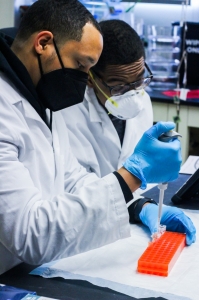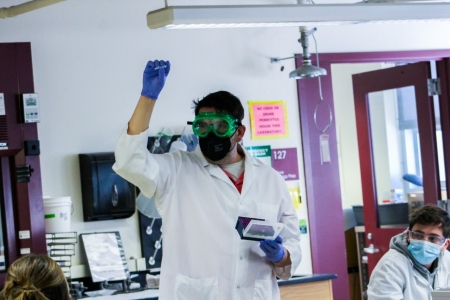“Vaccines and Public Perception” Course Approaches Public Education Surrounding Vaccinations

There is a wide array of opinions on vaccinations in today’s world. Joseph Comber, PhD, associate teaching professor in Biology, developed the course “Vaccines and Public Perception” to delve into science communication and education of vaccines to the public.
“One of the goals of this course is to talk about a lack of basic communication about what vaccines are, why they’re good and what they’re used for,” said Comber.
This course dives into the issues of science communication that may contribute to the small but growing opposition to vaccines, even as more is done to show that vaccines are safe and effective. An aim of the course is to discuss how non-scientists perceive communication surrounding vaccines.
This course is available to all majors, which makes it even more valuable, says Comber. Students of non-science majors contribute a diversity of ideas and opinions which are essential to understanding all perspectives on vaccines. Part of the course work is an opinion paper, to encourage students to create informed stances considering science and other factors.
The course includes lectures and lab components. The lecture gives students a dose of science education as well as constructive conversations, with the goal of understanding how the perception of vaccines can influence decision-making. Comber’s goal is to let the students direct the class by their interests. “If we are talking about the history of vaccination, I let the students dictate how long and how in-depth we want to delve into a topic.”
With the everchanging state of the world, the course aims to follow current news and vaccines. “Each cohort is allowed a unique learning experience happening in real time,” said Comber, who is in his fourth year teaching the course.
In the Spring of 2020, the course studied an emerging virus coming from Wuhan, China and the following year discussed COVID-19 vaccine rollouts. This semester, Comber is discussing communication surrounding mask mandates and inequities in COVID-19 vaccine distribution. For instance, globally, there are countries with very small populations of vaccinated publics, while others are already rolling out booster shots.

In the lab, students collect samples to demonstrate that microbes are everywhere and on everything. To make learning more tangible, in the lab component Comber utilizes activities to supplement the impact of vaccinations. Students participate in a vaccine simulation which uses a powder that glows under ultraviolet light. In each simulation, a different number of students in the classroom serve as vaccinated or unvaccinated participants and go about the classroom, spreading the powder. When almost everyone in the room serves as a vaccinated participant, you don’t see the fluorescent germs anymore, illustrating herd immunity.
Throughout the semester, students apply what they have learned through projects and assessments. To further address the public understanding of science, students create a campaign for a vaccine rollout directed at the public. The course also includes an option to produce a podcast interviewing people on their own vaccine perceptions and experiences.
At the end of the course, students walk away with an understanding of the importance of the communication and public education of vaccines.
“Students take away an understanding of how vaccines work, how they’re effective, their development and history,” Comber says. “The other part is an understanding of what the public perception of vaccines actually is, how non-scientists think about vaccines, how they perceive the risks and dangers of vaccines and how to reach people on the fence who are hesitant about vaccines.”
